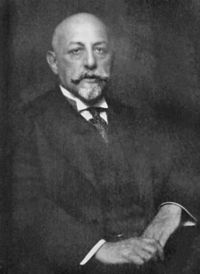Robert Mond
| Sir Robert Mond | |
|---|---|
 |
|
| Born | 9 September 1867 Farnworth, Widnes, Lancashire, England |
| Died |
22 October 1938 (aged 71) Paris, France |
| Residence | England, France |
| Nationality | English |
| Fields | Chemist, archaeologist |
| Institutions | Brunner Mond & Company |
| Alma mater |
Peterhouse, Cambridge, Zurich Polytechnic, University of Edinburgh, University of Glasgow |
| Doctoral advisor | William Thomson |
| Known for | Discovery of carbonyl compounds Egyptian archaeology |
| Notable awards | Messel medal of the Society of Chemical Industry Chevalier of the Légion d’honneur |
Sir Robert Ludwig Mond, FRS,FRSE (9 September 1867 – 22 October 1938) was a British chemist and archaeologist.
Robert Mond was born at Farnworth, Widnes, Lancashire, the elder son of Ludwig Mond, chemist and industrialist. He was educated at Cheltenham College, Peterhouse, Cambridge, Zurich Polytechnic, the University of Edinburgh and the University of Glasgow. At Glasgow he studied under William Thomson.
He collaborated with his father in the discovery of the gaseous compound nickel carbonyl. He perfected the industrial production of iron carbonyl, and discovered the first derivative of a metallic carbonyl (cobalt nitroso-carbonyl) and a new ruthenium carbonyl. For a time he made trials of scientific farming. Following his father's heritage he became a director of Brunner Mond & Company and because of a connection with nickel mines in Canada he was a trustee of the Royal Ontario Museum in Toronto.
He then took an interest in Egyptian archaeology and worked with some of the major archaeologists of the time, including Percy Newberry, Howard Carter, Arthur Weigall and Alan Gardiner. With the last named he worked on the Theban necropolis. After World War I he was involved with the preservation of the tomb of Ramesses. He built up a considerable collection of artefacts which he bequeathed to the British Museum. He also performed archaeological work in Palestine, France and the Channel Islands and assisted in the foundation of a British School of Archaeology in Jerusalem. Robert Mond also took an interest in model soldiers building up a collection of 900 figures representing all the regiments in Napoleon's army.
...
Wikipedia
